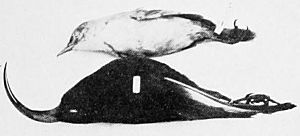Black mamo facts for kids
Quick facts for kids Black mamo |
|
|---|---|
 |
|
| Black mamo (Drepanis funerea) | |
| Conservation status | |
| Scientific classification | |
| Genus: |
Drepanis
|
| Species: |
funerea
|
The black mamo (Drepanis funerea), also known as the hoa, was a special kind of bird that lived only on the island of Molokai in Hawaii. Sadly, this bird is now extinct, meaning there are no more black mamos left in the world. Scientists have also found old fossils that show it once lived on Maui too.
Contents
What Did the Black Mamo Look Like?
The black mamo was about 8 inches (20 cm) long, which is roughly the size of a small ruler. Its feathers were mostly black. It had some faded white feathers on its wings and a bit of yellow near the bottom of its beak.
Its beak was very special. It was long and curved downwards, almost like a sickle. The male birds had even longer, more curved beaks than the females. Sometimes, pollen from its favorite flowers, called Lobelia, would dust its forehead.
The black mamo's song was unique. It sounded like a flute playing nose whistles, followed by a long, drawn-out trill. People called this bird by many names, including "Molokai mamo" and "o’o nuku’umu," which means "o’o with a sucking beak." It was also called "Perkins's mamo" after a scientist named R.C.L. Perkins, who studied these birds a lot.
Where Did the Black Mamo Live?
The black mamo preferred to live in the lower parts of the forest, among the plants and trees that grew close to the ground. This area is called the understory.
Why Did the Black Mamo Disappear?
Sadly, the black mamo faced many challenges that led to its extinction. When people brought new animals like cattle and deer to Molokai, these animals ate and trampled the plants in the forest. This destroyed much of the black mamo's natural home.
Also, new animals like rats and mongooses were introduced to the island. These animals hunted the black mamos and ate their eggs, making it very hard for the birds to survive and have babies.
Discovery and Legacy
The black mamo was first discovered in 1893 in a place called the Pelekuna Valley on Molokai. Scientist R.C.L. Perkins gave it the name Drepanis funerea. He chose "funerea" because the bird's dark color made him think of mourning.
The very last black mamo that scientists recorded was collected in 1907 by William Alanson Bryan. After this, sightings of the bird became very rare. Even a big search for the black mamo in 1936 found no more birds.
Today, you can see preserved black mamo specimens in museums around the world. Some are kept in cities like Bremen, Boston, Honolulu, London, and New York City. These specimens help us remember this unique Hawaiian bird that is now lost forever.
See also
 In Spanish: Mamo negro para niños
In Spanish: Mamo negro para niños



